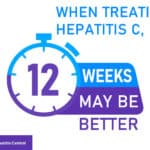Diabetes Prevention a Priority with Hep C
Approximately 50 percent of the millions of people living with Hepatitis C are lucky enough to defeat the virus with interferon combination therapy. For the other half of people infected, the therapeutic goal remains to prevent their liver disease from progressing to cirrhosis or liver cancer. While stopping the worsening of liver disease constitutes approaches ranging from lifestyle changes to herbal supplements to unproven drug therapies, diabetes prevention appears to be more important than ever.
According to the American Diabetes Association, there are 20.8 million Americans living with diabetes. While an estimated 14.6 million have been diagnosed, experts estimate that about 6.2 million people are currently unaware that they have the disease. Although nobody wishes this increasingly common problem upon themselves new research points to another reason for practicing diabetes prevention. According to a recently published study from the Netherlands, having diabetes increases the risk of liver cancer for those with chronic Hepatitis C with advanced fibrosis or cirrhosis.
Study Details
Researchers at the Erasmus MC University Medical Center in Rotterdam analyzed data on 541 European and Canadian patients with advanced, chronic Hepatitis C. The researchers discovered that patients with more severe liver fibrosis were more likely to have diabetes. In addition, they concluded that individuals with advanced Hepatitis C and diabetes were at increased risk of developing liver cancer.
The severity of fibrosis was assessed by an Ishak fibrosis score, a system that measures the degree of scarring (fibrosis) of the liver:
- Stage 0 represents no fibrosis
- Stage 1 and 2 indicate degrees of fibrosis where there is minimal scarring around liver blood vessels
- Stage 3 indicates scarring extended out from liver blood vessels
- Stage 4 means that the scarring has formed bridges between blood vessels
- Stage 5 indicates nodular formation in the liver
- Stage 6 represents cirrhosis
According to researchers, the higher a person with Hepatitis C’s Ishak score, the more likely they were to have diabetes:
- Of those with an Ishak score of four, 10.5 percent had diabetes mellitus
- Of those with an Ishak score of five, 12.5 percent had diabetes mellitus
- Of those with an Ishak score of six, 19.1 percent had diabetes mellitus
Among the participants with diabetes, the study found an increased occurrence of liver cancer. As the primary test warning of diabetes (fasting glucose test) showed increased amounts of sugar in the blood, the risk of developing liver cancer also increased. The authors of the study postulated that hyperinsulinemia might explain the increased liver cancer risk among diabetic patients.
What is Hyperinsulinemia?
Although it does not necessarily equate to diabetes, hyperinsulinemia means having too much insulin in the blood. Unfortunately, hyperinsulinemia often leads to adult onset diabetes. Insulin is produced by the pancreas to help regulate blood sugar. The most common cause of hyperinsulinemia is insulin resistance, a condition where the body is resistant to insulin’s effects causing the pancreas to compensate by making more insulin.
Prevention
There is great hope for those who have hyperinsulinemia to prevent diabetes. The American Diabetes Association’s Diabetes Prevention Program (DPP) study conclusively showed that people with pre-diabetes can prevent the development of type 2 diabetes by making changes in their diet and increasing their level of physical activity. They may even be able to return their blood glucose levels to within normal range. Despite the DPP showing that some medications may delay the development of diabetes, diet and exercise had the most dramatic results. Just 30 minutes a day of moderate physical activity, coupled with a 5-10 percent reduction in body weight, produced a 58 percent reduction in diabetes.
Although the authors of this Dutch study do not explain why excessive amounts of insulin predispose someone to developing liver cancer, future studies are sure to investigate this established connection. In the meantime, this research warns people with chronic liver disease to take diabetes prevention seriously. It is now clearer than ever that those with Hepatitis C who don’t want liver cancer to be a part of their future must make diet and exercise their immediate priority.
References:
www.caringmedical.com, Condition: Hyperinsulinemia, Caring Medical & Rehabilitation Services, 2008.
www.diabetes.org, Diabetes Statistics, American Diabetes Association, 2008.
www.diabetes.org, How to Prevent or Delay Diabetes, American Diabetes Association, 2008.
www.idenix.com, Glossary of Terms, Idenix Pharmaceuticals, 2008.
www.mayoclinic.com, Hyperinsulinemia: Is it Diabetes?, Maria Collazo-Clavell, MD, Mayo Foundation for Medical Education and Research, 2008.
www.nlm.nih.gov, Diabetes Boosts Liver Cancer Risk in Hepatitis, Cirrhosis Cases, Robert Preidt, June 2008.
www.phoenixcme.org, Liver Fibrosis, phoenixcme.org, 2008.







